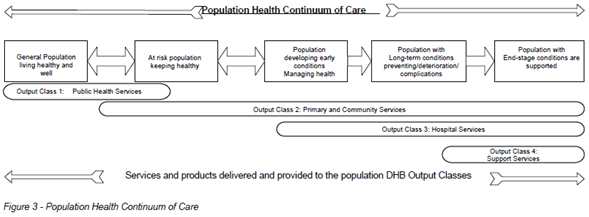3.3 Differentiating impacts from outputs - Hawke's Bay DHB
| Differentiating between impacts and outputs |
|---|
| DHBs are required to specify outcomes and/or impacts in the SOI. Impacts are the contribution made to an outcome by a specified set of outputs and/or actions. Outputs are the goods or services produced by the DHB. In previous years, DHBs have often reported low-level impacts, and their associated performance measures, as if they were outputs (and their associated measures). This may be at least partly because:
Nevertheless, being as clear and consistent as possible in differentiating impacts from outputs is important. The impacts should demonstrate whether the DHB’s services are effective and the DHB is providing the "right" services, within the broader context of its outcomes. |
Hawke’s Bay DHB identifies five impacts (in addition to outcomes). Its impact measures and targets are similar to other DHBs. However, what sets it apart from some DHBs is the attention it pays to the impacts, with specific narrative discussion on each of them, and the clear differentiation of impacts from outcomes and outputs.
The impacts are clearly set as the bridge between health services and desired outcomes, as shown by the following two statements.
"The following section [3.5 Outcomes and Priorities] outlines HBDHB’s intervention logic, which links our output plans to the highest level outcomes and demonstrates how we will meet national, regional and district priorities and measure progress toward achievement of the outcomes sought."
"In order to contribute to these outcomes [four outcomes it has outlined] HBDHB considers the impacts of our outputs on the population that we serve."
Context from the Population Health Continuum of Care
The SOI presents an overview of the continuum of care for population health and the most relevant set of services at each point on the continuum to give useful context to the ensuing discussion on impacts.

Information provided on each impact
Hawke's Bay DHB highlights the impacts by presenting them as headings:
"Impact 1: People are better protected from harm, more informed to support healthier lifestyles and maintenance of wellness, and inequalities are reduced"
It clearly and succinctly explains what this means and the rationale for the impact. There is a clear focus on the effectiveness of services.
Hawke’s Bay DHB then identifies which output class(es) and services primarily contribute to the impact. For example:
"Hawke’s Bay DHB programmes in this area include health promotion and education services, statutory and regulatory services, population based screening programmes, immunisation services, well-child services and school health services."
Finally, there is a sub-section under each impact titled How will we demonstrate success? This section identifies and expands on the choice of performance measures (which are identified in a table after the discussion of impacts).
The example below, on fruit and vegetable consumption, relates to one of two measures Hawke’s Bay DHB plans to use to monitor nutrition:
"Fruit and vegetables are highly nutritious and have been shown to protect against a range of chronic diseases, including heart disease, stroke and many cancers. In New Zealand it is recommended that adults eat at least three servings of vegetables and 2 servings of fruit daily and we will use the New Zealand Health Survey to show if our efforts at promoting this is effective in our district."
The sentences confirm the rationale for the choice of measure (protection against chronic diseases), the role of the DHB (promotion – linking back to earlier discussion under the impact), the focus on understanding the impact of the DHB’s health promotion services (the effectiveness of its efforts), and the links back to outcomes (protection against chronic diseases will result in better health for the community).
page top